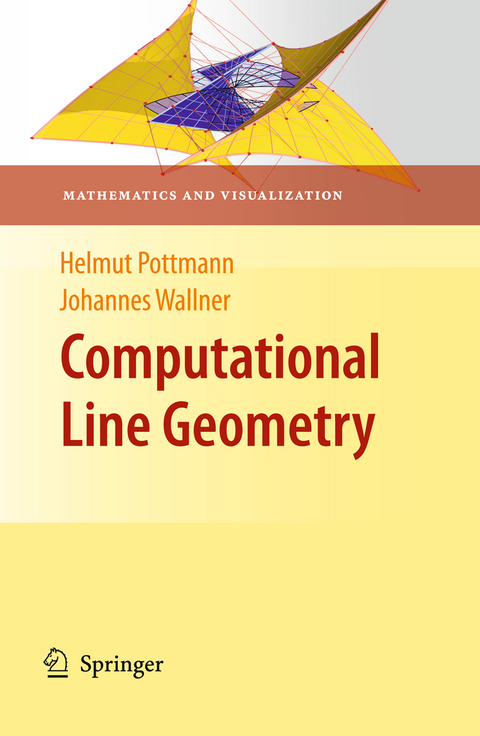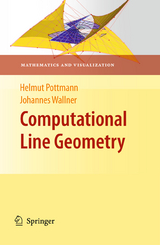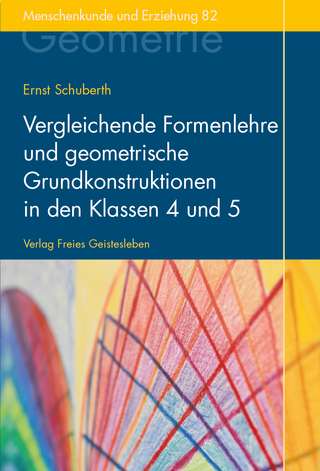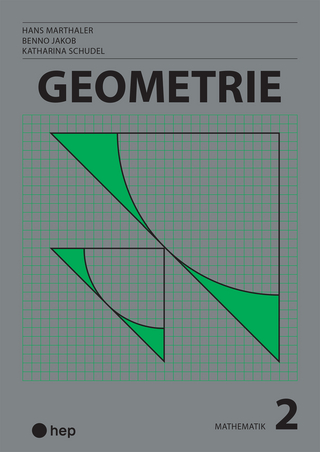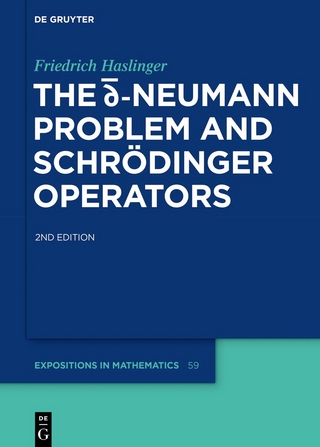Computational Line Geometry
Springer Berlin (Verlag)
978-3-642-04017-7 (ISBN)
Helmut Pottmann ist Professor für Geometrie an der Technischen Universität Wien und seit 2009 Direktor des Forschungszentrums für Geometrische Modellierung und wissenschaftliche Visualisierung an der King Abdullah University of Science and Technology in Saudi Arabien. Er hatte Lehr- und Forschungsaufträge ua. an Universitäten in Hamburg, Kalifornien und Peking.
Preface.- 1. Fundamentals.- 2. Models of Line Space.- 3. Linear Complexes.- 4. Approximation in Line Space.- 5. Ruled Surfaces.- 6. Developable Surfaces.- 7. Line Congruences and Line Complexes.- 8. Linear Line Mappings - Computational Kinematics.- References.- List of Symbols.- Index.- Color Plates.
From the reviews of the first edition:
"... The depth of the presentation is one of the striking things about this work. It does not only scratch the surface of the numerous fields but delves into the matter meticulously. But all the same there is enough room left for applications which keep the book exciting, not only for students and mathematicians but also for ambitious engineers. ... I can well imagine that this book will render a tremendous service to many of its readers. I wholeheartedly recommend this outstanding monograph."
J.Lang (Graz), IMN - Internationale Mathematische Nachrichten 190, 2002, pp. 65-66
"...There is a vast amount of fascinating geometry of all sorts in this book. The topics are perhaps somewhat eclectic - they mirror the primary interests of the authors - but, because the motivation is to develop the geometry that applies to real world problems, the subject is far from monolithic and is open to interpretation. The ideas here build up layer upon layer. In the end, the authors have been mostly successful in sustaining their central theme, despite the need to weave together projective, differential, algebraic and metric geometry. They have also presented the mathematics in a predominantly modern way. That is important because there exist in the engineering literature archaelogical remnants of outdated notation and concepts. [....] The large number (264) of line diagrams are of very good quality and considerably enhance one's understanding. [...] a book which is without doubt an important contribution to this growing branch of geometrical research."
P. Donelan (Wellington) - New Zealand Matheamtical Society Newsletter 87, April 2003.
"The authors have combined results from the classical parts of geometry with computational methods. This results in a unique and fascinating blend, which is shown to be useful for a variety of applications, includingrobotics, geometrical optics, computer animation, and geometric design. The contents of the book are visualized by a wealth of carefully chosen illustrations, making the book a sheer pleasure to read, or even just browse in. The book will help to bring the concepts and techniques of line geometry, which have been shown to be useful for various applications in geometric design and engineering, to the attention of a wider audience."-
MATHEMATICAL REVIEWS
"The didactically well-considered and marvelously illustrated book is self-contained at least for readers acquainted with basic concepts of (classical) differential geometry and CAGD, and, of course, with (advanced) linear algebra and some calculus. The reader of this demanding textbook is richly rewarded by applicable knowledge, and he surely will enjoy the elegance of geometric reasoning and the effectiveness of line-geometric calculations."
(Gunter Weiß, Zentralblatt MATH, Vol. 1006, 2003)
"... In der Einleitung schreiben die Autoren, dass ihnen von verschiedenen Kollegen naheglegt wurde, ein Buch über "klassische" Geometrie und deren Anwendung auf geometrisches Rechnen zu schreiben. Da ihnen diese Aufgabe als zu umfangreich erschien, haben sie sich hier auf die Geraden-Geometrie beschränkt. Sie haben damit eine sehr glückliche Wahl getroffen: Einserseits ist diese Darstellung thematisch einheitlich und geschlossen, andererseits wird eine schier unglaubliche Fülle von Material detailliert beschrieben. ... Das Buch enthält 237 sehr informative und sorgfältig ausgeführte Illustrationen und 17 Farbtafeln. Damit ist das Buch auch ästhetisch sehr beeindruckend. Das Buch wird wohl ein Standard-Werk für die sogenannte "Angewandte Geometrie" werden, eine Weiterentwicklung der traditionellen Ingenieurs-Geometrie mit modernsten Methoden."
W.Barth (Erlangen), Jahresbericht der DMV 105, Band (2003), Heft 2
From the reviews of the first edition:
"... The depth of the presentation is one of the striking things about this work. It does not only scratch the surface of the numerous fields but delves into the matter meticulously. But all the same there is enough room left for applications which keep the book exciting, not only for students and mathematicians but also for ambitious engineers. ... I can well imagine that this book will render a tremendous service to many of its readers. I wholeheartedly recommend this outstanding monograph."
J.Lang (Graz), IMN - Internationale Mathematische Nachrichten 190, 2002, pp. 65-66
"...There is a vast amount of fascinating geometry of all sorts in this book. The topics are perhaps somewhat eclectic - they mirror the primary interests of the authors - but, because the motivation is to develop the geometry that applies to real world problems, the subject is far from monolithic and is open to interpretation. The ideas here build up layer upon layer. In the end, the authors have been mostly successful in sustaining their central theme, despite the need to weave together projective, differential, algebraic and metric geometry. They have also presented the mathematics in a predominantly modern way. That is important because there exist in the engineering literature archaelogical remnants of outdated notation and concepts. [....] The large number (264) of line diagrams are of very good quality and considerably enhance one's understanding. [...] a book which is without doubt an important contribution to this growing branch of geometrical research."
P. Donelan (Wellington) - New Zealand Matheamtical Society Newsletter 87, April 2003.
"The authors have combined results from the classical parts of geometry with computational methods. This results in a unique and fascinating blend, which is shown to be useful for a variety of applications, includingrobotics, geometrical optics, computer animation, and geometric design. The contents of the book are visualized by a wealth of carefully chosen illustrations, making the book a sheer pleasure to read, or even just browse in. The book will help to bring the concepts and techniques of line geometry, which have been shown to be useful for various applications in geometric design and engineering, to the attention of a wider audience."—
MATHEMATICAL REVIEWS
"The didactically well-considered and marvelously illustrated book is self-contained at least for readers acquainted with basic concepts of (classical) differential geometry and CAGD, and, of course, with (advanced) linear algebra and some calculus. The reader of this demanding textbook is richly rewarded by applicable knowledge, and he surely will enjoy the elegance of geometric reasoning and the effectiveness of line-geometric calculations."
(Gunter Weiß, Zentralblatt MATH, Vol. 1006, 2003)
"... In der Einleitung schreiben die Autoren, dass ihnen von verschiedenen Kollegen naheglegt wurde, ein Buch über "klassische" Geometrie und deren Anwendung auf geometrisches Rechnen zu schreiben. Da ihnen diese Aufgabe als zu umfangreich erschien, haben sie sich hier auf die Geraden-Geometrie beschränkt. Sie haben damit eine sehr glückliche Wahl getroffen: Einserseits ist diese Darstellung thematisch einheitlich und geschlossen, andererseits wird eine schier unglaubliche Fülle von Material detailliert beschrieben. ... Das Buch enthält 237 sehr informative und sorgfältig ausgeführte Illustrationen und 17 Farbtafeln. Damit ist das Buch auch ästhetisch sehr beeindruckend. Das Buch wird wohl ein Standard-Werk für die sogenannte "Angewandte Geometrie" werden, eine Weiterentwicklung der traditionellen Ingenieurs-Geometrie mit modernsten Methoden."
W.Barth (Erlangen), Jahresbericht der DMV 105, Band (2003), Heft 2
| Erscheint lt. Verlag | 9.2.2010 |
|---|---|
| Reihe/Serie | Mathematics and Visualization |
| Zusatzinfo | X, 564 p. 264 illus., 17 illus. in color. |
| Verlagsort | Berlin |
| Sprache | englisch |
| Maße | 155 x 235 mm |
| Gewicht | 955 g |
| Themenwelt | Mathematik / Informatik ► Mathematik ► Geometrie / Topologie |
| Schlagworte | Animation • area • Clipping • geometric design • Kinematics • line geometry • Scientific Computing • Visualization |
| ISBN-10 | 3-642-04017-9 / 3642040179 |
| ISBN-13 | 978-3-642-04017-7 / 9783642040177 |
| Zustand | Neuware |
| Haben Sie eine Frage zum Produkt? |
aus dem Bereich
